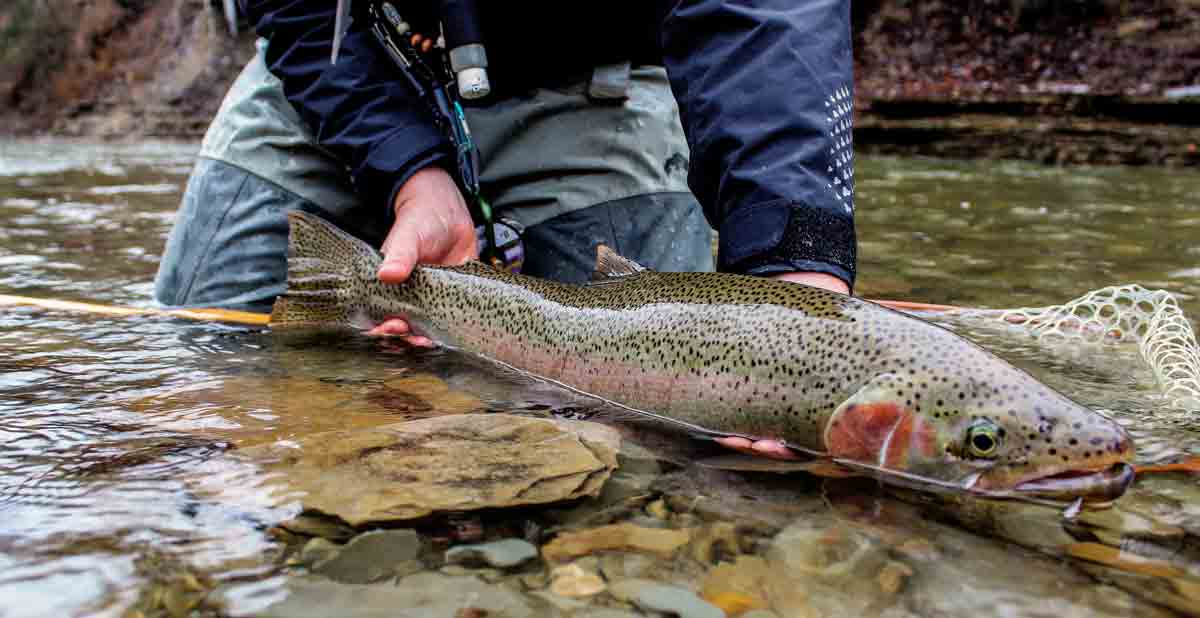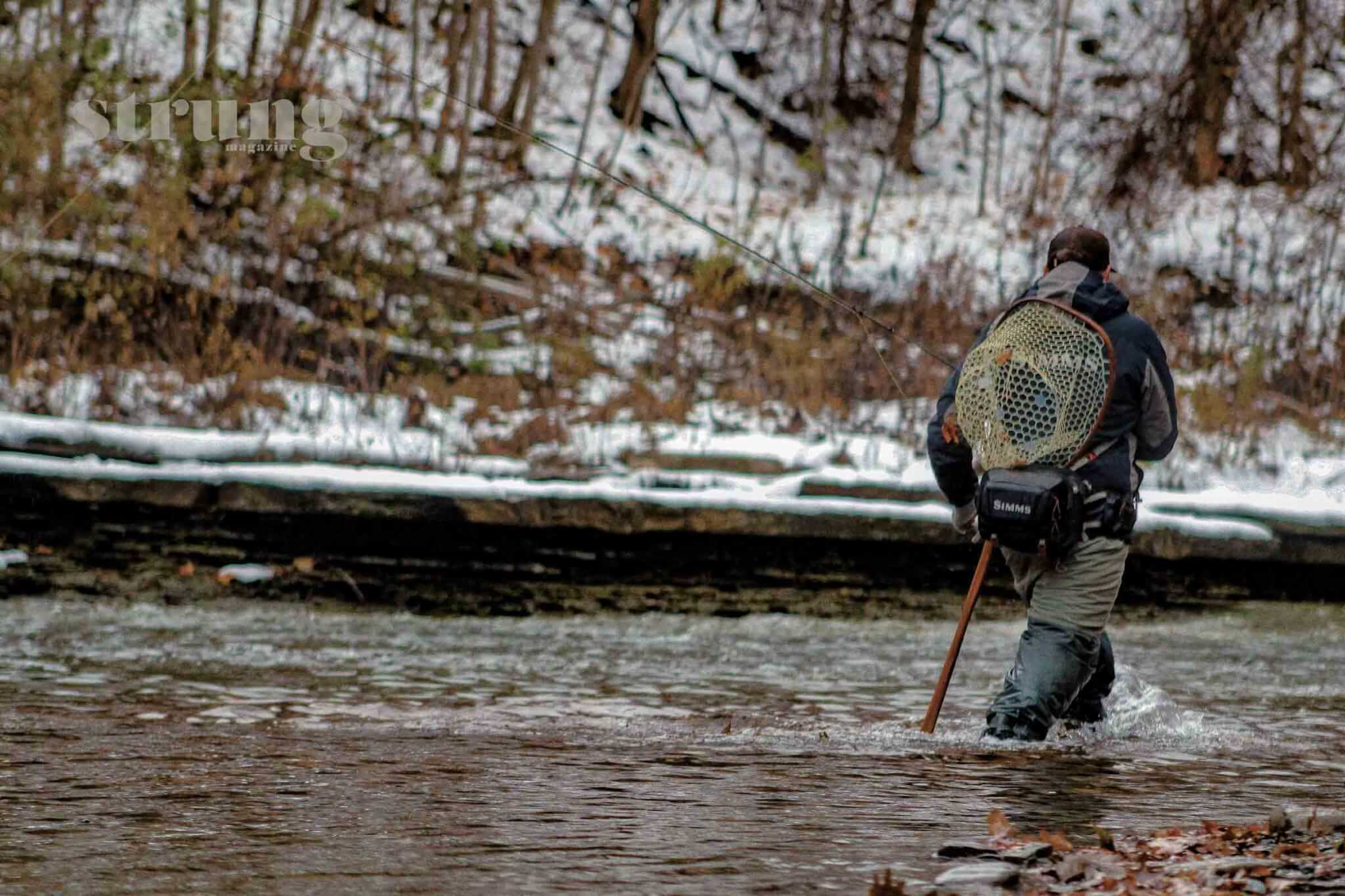Anglers spend countless hours walking up and down the slate-lined streambanks in search of a shadowy fin, a tail, or the unmistakable flash of a feeding fish. Nary a cast is made without prior confirmation that a steelhead is present, and even if a fish is spotted, hooking one is far from a foregone conclusion.
The many small streams along the Pennsylvania’s Lake Erie coastline offer a unique setting for chasing such an unforgettable fish as the steelhead. These aren’t the temperate, rainforest-lined glacial rivers of the Pacific Northwest that grace the covers of magazines and books. To experience fishing for these monsters of the deep is intoxicating and addicting. While their time in the “tribs” (rivers flowing into Lake Erie) might be fleeting, thoughts of their arrival and our pursuit of them is something that never wanes. It becomes a lifestyle.
Lake Erie steelhead are a sight fisher’s paradise, and with that uniqueness lies a challenge that’s unlike anything else in fly fishing. It’s not often that using multiple egg patterns with a brace of split-shot is categorized as technical, but the small streams, gin-clear water, and sight fishing to 30-inch steelhead weave a style of angling that’s not found in many places.
When you’re probing for these behemoths, they seem docile and almost tepid, much tamer than the stories of old in Field & Stream and fly-fishing catalogues. To the unsuspecting, a holding steelhead might seem an inch from death as it waves its fins just barely enough to stay put and is in no hurry to go anywhere fast. This notion comes to a screeching halt when a steelhead hits, and it becomes painfully clear this was all nothing more than a carefully executed ruse.
Drift after drift can run near these supersized rainbow trout while their interest seems minimal at best. Then out of nowhere, a strike indicator pauses for the briefest of moments and the entire day changes in a split second with the realization that a chrome torpedo is now on the line. Time stands still and the fish ascends to the surface with thrashing, violent head shakes as it tries to determine what is happening. The fight is on. This is steelheading in Pennsylvania.
After the first few heart-stopping seconds, when all parties are trying to get their bearings, the battle is akin to boxing an alligator in a phone booth. The steelhead is a fish that spends eight months a year living in the depths of an immense playground where it can go where it wants, when it wants. To ascend from the icy depths of Lake Erie to these tiny tributary streams is about as stark a difference as going from downtown Erie—with its factories and warehouses—to the quaint farmland of inland Pennsylvania only a few miles away. Steelhead apparently don’t care about the confines of their new stream homes, and they cartwheel and rip line as though they still have an entire Great Lake at their disposal.
 Steelhead don’t belong in these streams, but don’t tell them that. They are quite at home in the Great Lakes, despite their native range being several thousand miles away in the Pacific. The bays and lagoons surrounding Erie, Cleveland, and Buffalo might be a far cry from the Bering Sea and Puget Sound, but the attitude of the fish endures. They have just traded the tang of salt for the tartness of rust, thanks to shipwrecks loaded with iron ore.
Steelhead don’t belong in these streams, but don’t tell them that. They are quite at home in the Great Lakes, despite their native range being several thousand miles away in the Pacific. The bays and lagoons surrounding Erie, Cleveland, and Buffalo might be a far cry from the Bering Sea and Puget Sound, but the attitude of the fish endures. They have just traded the tang of salt for the tartness of rust, thanks to shipwrecks loaded with iron ore.
There’s a ruggedness about these fish; perhaps it’s perpetuated by the region their ancient ancestors called home, or maybe it’s thanks to their battle scars after a tangle with a hungry pike or muskie. Whatever the reason, the steelhead of Pennsylvania have a toughness about them that’s on full display in their screaming runs and their ability to spend the winter entombed under ice that locks in the streams each January.
That winter of ice holds another piece to the steelhead hardship puzzle. The months when steelhead enter the streams happen to coincide with some of the harshest weather imaginable. Extreme cold, blinding snow, and biting wind aren’t reserved for Siberia, Wyoming, and the Arctic Circle. To anyone familiar with Great Lakes steelheading, the lyrics of Gordon Lightfoot’s song “The Wreck of the Edmund Fitzgerald” sounds more like a Tuesday morning weather report than romanticized embellishment.
The dullness of walking, peering into water totally devoid of life, and countless refusals seem like distant memories when a steelhead is frantically racing downstream toward the lake, which could be many miles away. It doesn’t take many days fishing for steel in Pennsylvania to understand why hundreds of thousands of anglers flock here from all corners of the country. Other fisheries undoubtedly have prettier backdrops, more elegant fishing methods, and of course the opportunity to catch fish in their historic range, but none of that matters to those who travel to the Keystone State in search of chrome.
By Nick DelVecchio
Photos by Stephanie DelVecchio
Nick DelVecchio is a freelance outdoor writer and the owner/head fishing guide at Wildwood Outfitters. He guides anglers of all skill levels on the many trout waters in Pennsylvania, providing all of the necessary gear on trips customized for each guest.


